|
| ||
|
Blueberries |
Grafting
Add Variety to Your Orchard, and Fun to Your Experience
|
|
|
Our grafting adventure started thanks to stem borers. I lost a number of young purchased trees to those little creatures before I knew to watch for them or protect the young trees from them. After the tops died the rootstocks sent up new shoots. The trees (apples) had been grafted onto hardy standard Antonovka stock. It seemed a shame not to do something with them so I started thinking about and researching grafting. In 2011 I purchased a few scions and, with instructions and drawings in hand, we grafted a Honeycrisp apple onto a regrown Antonovka rootstock in the orchard, and a section of the scion onto a vigorous wild sapling near the shop, using the whip & tongue technique. There was a young but fruiting medium-small seedling cherry-plum in the orchard that had three conveniently located branches. I had two plum varieties, LaCrescent and Underwood, so these were cleft grafted onto two of the branches since the size difference was too large for w&t. I was going to leave the third limb original but since the fruit wasn't eating quality (small fuit, large pit, little flesh) I clipped a tip from the nearby Gracious plum and Steve put that on. Our grafting was done for the year, a small but exciting start. The trees were fortunate to have an accomplished woodworker (Steve) to do the knife work. As the passionate budding orchardist I did the planning, wrapping and follow-up, a successful partnership that has continued to this day. To our delight they all took and grew well. The plums in particular were very vigorous since they were on an older rootstock. The tree grafts flowered and had fruit in 3-4 years. The apples grew well but haven't fruited yet, though it looks like it will be soon. Slower to bear being apples and because they were grafted on young rootstock, and Honeycrisp is known to be slowish to come into bearing. I'm looking forward not only to the fruit but to compare the fruit grown on two different rootstocks and different environments. We were hooked, and have grafted every year since. The number of grafts each year grew as the orchard expanded, and will slow down now that the orchards are getting full. But the fun of watching the grafts grow and mature and fruit will continue. It's a great way to build an orchard. 2021 -- Early Warmth means Early Grafting With everything growing early and fast due to the very warm spring I suddenly realized the trees were leafing and ready to graft. May 12 we grafted two Juneberry scions -- Thiesen to a well branched medium young native sapling by the north fence; and a Honeywood to an older one near the south fence where we had grafted last year with no takes. Both scions were cut from grafts made last year onto two bearing native juneberries in the east rough patch. The Thiesen didn't take but the Honeywood did and grew well. May 17 was the main grafting day but much fewer than recent years, only 18 total, all cut from own trees, most for adding additional branch grafts on base tree. Three plums, scions cut from own trees, none took (storage? timing?). Two more self cut Sierra grafts on Summercrisp pear, took and grew. Ten apples: Carroll, Starkey, Akero, Prairie Spy, Zestar all good. Goodland, Wynoochee, Discovery didn't take. Considering the late May freezes and record hot summer I was happy most of them did well. Limited grafting will be needed next year.
It was a day to do something special, even if only to admire and enjoy the wonderful clear sunny day, which we did. The batteries were full early, the woodstove banked as the solar heating panels cranked in the heat, and it certainly was cheery out, and in. Though a bit chilly with a brisk breeze I decided today was the day to walk the orchard (on snowshoes - still have more than 2 feet of snow on the ground) and cut scions, the first orchard activity (other than planning) of the new year. Usually I only have a few scions to cut off my own trees, mainly to trade with other backyard growers. But this year our grafting will be from our own trees, onto our own trees.
It may be I want to move a variety from one tree to another, others will
be to graft a new variety onto other branches of the same tree. Some are
due to change of mind, some simply expanding the amount of a particular
variety. A few are vigorous shoots on a graft that are growing where I
don't want them to so need to be pruned off. And since I will then have
a piece that could be grafted elsewhere why not find a place to put it?
This is a "problem" with many of us small orchardists, who get excited
about each new variety, each successful graft, and tend to see every
pruning as a potential scion to be grafted somewhere else. I'm getting
over that as my orchard is filling up, and I've realized that two
varieties per tree is enough and easier to manage. Finally many of the
original grafts h Meantime, the 8" pieces of last year's growth, freshly cut, are now safely stored in the root-cellar, triple bagged to keep them from drying out or being affected by anything else in the root-cellar (the natural outgassing particularly of apples can "kill" a scion). Towards the end of May we'll be out in the orchard, walking on bare ground, on a warm day, re-attaching these bits of twigs which will one day down the road (if all goes well) grow an apple, or pear, or plum. It's an amazing and magical process. October 1, 2019 -- Apple Joy It's probably not a surprise to anyone who reads our website that apples are a bit of a passion for me. I'm not sure how I got so interested in them, but they do bring me a lot of pleasure, beyond simply as food. And it's getting even more fun as new apples that I've never seen nor tasted before start to fruit. This year there were three new grafts that set fruit, only a few each, and only one of one, but enough for a taste. They were our first apple grafts to bear fruit! All were on a branch of an established tree (not on their own rootstocks) which means there will never be many (unless we graft onto more branches) but it also means they fruit earlier than the ones on young small rootstocks. I was excited when I realized they had blossoms, and then thrilled when they fruited. These apples were given a great deal of watchful attention. Every time I passed the trees I looked to make sure the fruit was still there. Only one was inside the fence, the other two outside on a wild tree, vulnerable to a deer or squirrel lunch. Thankfully, we are in short supply of both this year.
The second variety came down five days later - the one and only apple of a Canadian variety called Goodland, just grafted last year. This was such a beauty it had been fun just to watch it grow. A large, 3" fruit, clean, I was really excited about this one. I set it on the counter for several days just to admire it. Then I carefully sliced it - nice, juicy. Gave Steve a piece and we both tried it. Hurray! This one is a keeper for sure. Delicious. We both liked it a lot. Sweet/tart flavor has an interesting sweet aftertaste. Can't wait for more of these. I'll be grafting it onto more branches (it's on one of our old Beacon trees) as soon as this original graft has grown enough wood to cut scions from.
2019 - September Grafting Report 53 grafts this year! May 27-31, nice weather, most w/t, , most apples and pears. It was a good feeling for almost all of the grafts and, excepting cherries, a very high success rate. It was a good growing year and the new grafts are going into the winter in good shape. 8 were done inside onto dug up rootstocks, grafted very low near the roots with the graft buried 4-5 inches when replanting, leaving one or two buds above ground to grow. This is with the hope that the scion will send out roots thereby getting a tree on its own roots instead of (or maybe along with) the rootstock. It is an interesting adventure. We did 2 apples, 1 pear, 2 cherries, and 4 apricots this way. The cherries rootstock whips (and last year's grafts) once again had a tough winter and almost all of the scions we received were very skinny. The combination didn't bode well for success. The two that took grew well though and I'm hopeful. But I've decided that the hardy Canadian bush cherries on their own roots are the best for us here so likely no more grafting of cherries. March 25, 2019 -- Waxing Scions Time
It is too early to do much of anything outside yet (we still have a foot
or so of snow covering the ground) but it's a great time to think and
dream of working in the orchard. Getting my scions out of the root
cellar to lay out, sort, wax, label, measure, admire, imagine them
growing, makes me feel close to that outer world. It may have only been
2 degrees outside this morning but it was spring in the kitchen!
The light layer of wax I've put on the scions will help keep them from drying out when they are grafted to their rootstocks. Some folks wrap their scions with a type of plastic tape or wrap (I've done that, too), some leave them bare (which we've also done), and a few of us give them the wax job - it all works! The wax or wrap gives them a little extra protection until they become established and growing and can take care of all that on their own. We won't be grafting for another two months so for now the scions are back in their plastic bags and back in the root cellar, to keep cool, quiet and dormant until that big day arrives. More information on our grafting and fruit growing is in the Orchard section (link is on the menu bar at the top of this page). 2018 - September Grafting Report Grafted May 27-30 -- 43 total grafts, mostly apple and pear, a few cherry and plum. Unusually warm spell (following record cold April). ‘Normal’ cool for short time then above normal temps June to Sept. Cold fall. Another unusual usual season. Scions were pre-waxed, most w&t grafts, a few tiny ones splice, with parafilm & splicing tape wrap. Had a few iffy scions, a few iffy rootstocks. Overall 56% take (24 grew) doesn't sound so good but I consider it a decent success rate since most that didn’t take were questionable scions or grafting experiments. It was a good growing season and those that took grew well as a whole. It's fun to try different things but good to keep an open mind as to chances of success. June 28, 2018 - Then suddenly -- Leaves!
Earlier in the month I looked out the front window to see a beautiful doe step carefully out of the brush and brambles into our mowed front path, looking back and I thought about ready to maybe scratch or lick a back leg or something. Then the brush wiggled and out emerged the smallest fawn I've ever seen, stumbling a bit over the growth. It had to be very young but it was mobile! Mom and baby soon disappeared back into the safety of the brush. A special moment. A few days ago I was walking through the area north of the garden, stopping to pick up a branch in my way and casually tossing it aside. Up jumped a larger fawn, leaping away from this woman throwing branches at it! I apologized. I also know it didn't go far. A reminder to watch our steps this time of year. Was it the same fawn? I don't know, it was well able to jump through the underbrush so my guess it's an older one. We often have several does with their fawns sharing our homestead, though we don't see them much. There's room for all of us. And a wonderful welcome to summer they are. SCIONS! - February 25, 2018
2017 - September Grafting Report Most of the 30 grafts we did in May grew, which is nice. A few I figure the scions were not good to begin with. A few we thought were pretty iffy and it would be a miracle if they grew -- a very small diameter scion grafted with a simple splice graft, because there wasn’t enough wood for a whip-and-tongue graft, onto a similarly very small rootstock or shoot. But to my surprise these took and are growing. Then there are a few that I don’t know why they didn’t grow any leaves from their buds as the scion is still alive (small scratch with a knife shows green cambium). We’ll see; there have been reports from others about scions popping the next spring. Hope so! [they didn't]. Then there is the one grafted upside down. I was a little sloppy with some of the waxing of the scions and what I thought was a bud pointing up was instead a glob of wax pretending it was a bud, and the real buds underneath went the other way. Oh well, we'll regraft that one next year. There is a lot of variety in the growth between them all, of course, so many different variables, but the rest show anywhere from just a few small leaves to more than a foot of growth. I love walking around cheering them all on. Spring update. Another tough winter with many short extremes of temperature fluxuations, up and down. The four cherries all winterkilled, as did one apple, or the rootstock did but that means the graft dies with it. Shows the hardiness of all the rest as the first few years are the hardest on new trees and this wasn't a kind winter. . Orchard - Grafts Popped! - June 16, 2017
In the photo above it is the part above the wrap that is the scion growing (a Patten pear). The growth below the wrap is the rootstock growth. Those shoots will be pruned off later when I'm sure the scion is firmly attached and growing as part of the rootstock. ORCHARD - Grafts Done! - May 26, 2017
If you look closely in the photo above you can see the scion piece looks a little odd. One trick towards successful grafting is to keep the scion from drying out before the graft calluses (and is then attached, connected and growing on the rootstock's root system). We don't have the problem with that here that they do in drier and windier areas, and didn't cover our scions (except for the top cut tip) the first five years of grafting and we've had very good success rates. But I want to give our grafts the best chance so at the recommendation of more experienced grafters I decided to cover the scions. Last year I wrapped the scions in Parafilm as we grafted. That worked well but was a little chancy as it's easy to wiggle the scion out of alignment (though we had excellent success rates last year, too). This year (2017) I decided to try the "wax" method (see below). I like it! SCIONS - WAXING - 2017
It didn't take long before I had a table covered with well waxed little sticks of wood; all labeled and ready to go back into their triple plastic bags and back in the root cellar until time to graft. The little colored clips on the scions in the photo are quilting/sewing/craft clips to attach the labels. It's too easy to get the scions mixed up! They worked well and were easy to remove and re-attach as we grafted pieces of the scions in the field. I liked the wax method. It was easy, spread out the work a little, and didn't interfere with the grafting. The buds pop right through the Parafilm or wax when they start growing. Grafting is a lot of faith, quite a bit of skill, and a whole lot of magic! 2016 Seven grafts, all apples, all took and grew. This was the first year I used the wrap technique of parafilm (a self-adhesive polyolefin tape, somewhat stretchy, flexible, breathable, degrades in sun) and rubber splicing tape over that (like black electric tape, somewhat stretchy, flexible, sturdy so can be pulled tight but will degrade in the sun so won't girdle a branch) (regular plastic electrical type must be cut off). This made taping much easier and I was very happy with it. Unfortunately the following winter was a particularly rough one and four of the six winterkilled. But the three that grew (2 varieties), hardy souls that they are, made it through and did fine. 2015 Three plums and four apples. The scions were all from the same source and it wasn't a good take - only 2 plums plus one cherry plum that was from our own tree grew. Was it the scions? the weather? the grafting? Hard to say but I learned to look carefully at the scions. If they don't look healthy and alive don't graft them. But most of the previous years grafts were still growing strong so we certainly weren't giving up. And the successful plums grew well. 2014 Only grafted one variety this year, but such an interesting one. Friends had given us a bucket of apples from an old tree growing near their house. The tree was likely planted, or grew from seed, in the early 1900's, a real nice green/yellow mild sweet fall apple. They didn't know the variety (if it was a named variety) but we all liked the apples. So we got permission to cut scions which we grafted, one on it's own rootstock, Antonovka, and one on a branch of a wild tree near the shop. Both grew well. [see October 1, 2019 report above]. We've named the variety Hoholik which is the name of the family who built the original homestead, and would have planted the tree by the door of their farmhouse. 2013 Four grafts this year, all but one on a very small wild sapling grew. Turned out that that wild sapling was an American Cranberry tree not an apple! I'd never before realized how hard it was to identify many species when they are that young. 2012 Our second year of grafting - 5 apples - all whip and tongue technique. We felt more confident this year, though I still felt all thumbs wrapping the thin pieces, scion and branch, with the small budding rubbers which were happy to spring back and unwrap if I relaxed my hold for even a split second. I'm grateful Steve can do w&t as it's sturdier than straight splice grafts so easier to wrap without moving that all important very, very thin cambium to cambium connection of the two pieces. But they all popped and started to grow! Hurray. May 30 the temperature fell to 15 degrees. All but one of the grafts froze, a Golden Russet on a seedling crab growing near the north woods, protected by the nearby large trees. All buds and blossoms on all fruit trees froze. No grafts but no fruit anywhere either. Such is life in the north woods. Disappointing but undeterred I immediately started planning for next year. Copyright © Susan Robishaw |
||
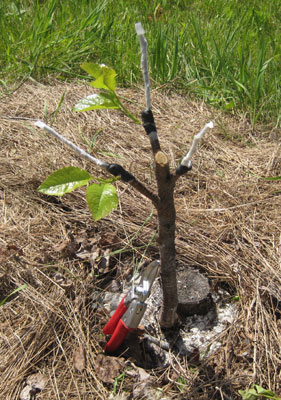
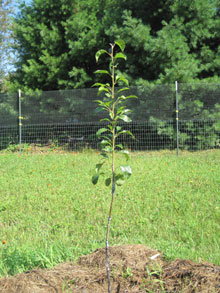
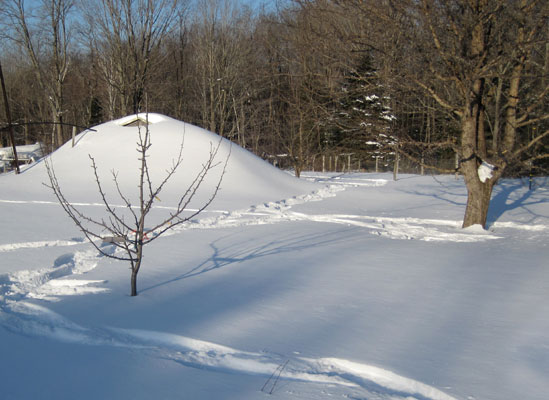 02-20-2020 -- A Beautiful Day, and a Magical Date!
02-20-2020 -- A Beautiful Day, and a Magical Date!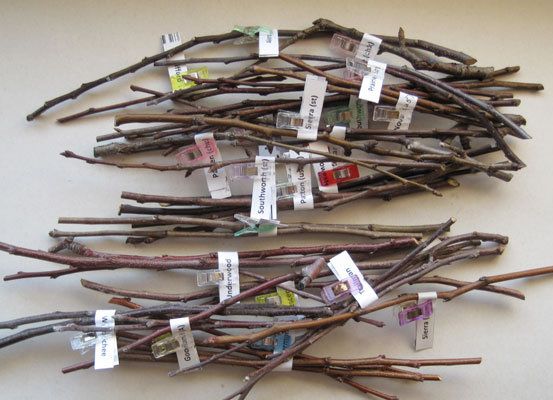 ave grown enough to be able to cut off a piece so I can
do this expansion. So that will be our grafting project this spring,
about 30 grafts total.
ave grown enough to be able to cut off a piece so I can
do this expansion. So that will be our grafting project this spring,
about 30 grafts total.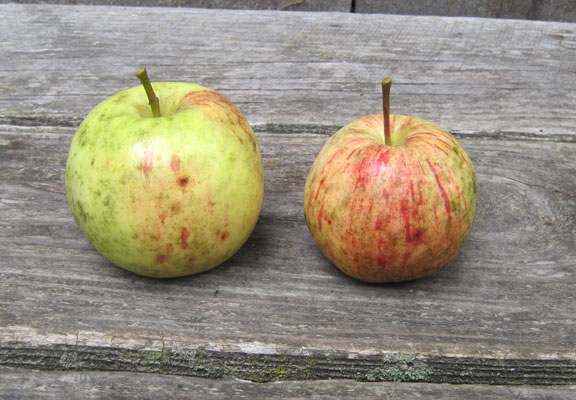 The
first to ripen (2 apples) was Nutting Bumpus (the names are
sometimes as much fun as the apples), a third year graft. One dropped mid September, the
other came off in my hand. Excited I took photos then sliced the smaller
one and took a bite. Mmm. Well, it was OK, but really wasn't very special. It tasted quite
like the wild tree it had been grafted to, though somewhat larger and
earlier. Rather tart but with flavor and some sweetness. It isn't a bad
apple, just not anything special. I had saved one of the two apples to see
how it would keep but today (Oct.1) found it was getting soft so
included it in a batch of
sauce I was making. I won't cut it off but I won't graft any more of it. To be fair,
apples often change as the tree ages and future crops may be different,
and this tree doesn't get as much sun as would be preferable.
But Nutting is a Duchess seedling and, not surprising, tastes a lot like the many Duchess
types that are all along the roads. Duchess of Oldenburg is an old and
hardy apple that was likely planted in most of the old orchards around
here. I'm not sure now why I chose this one to begin with. But it was
still exciting to have it fruit.
The
first to ripen (2 apples) was Nutting Bumpus (the names are
sometimes as much fun as the apples), a third year graft. One dropped mid September, the
other came off in my hand. Excited I took photos then sliced the smaller
one and took a bite. Mmm. Well, it was OK, but really wasn't very special. It tasted quite
like the wild tree it had been grafted to, though somewhat larger and
earlier. Rather tart but with flavor and some sweetness. It isn't a bad
apple, just not anything special. I had saved one of the two apples to see
how it would keep but today (Oct.1) found it was getting soft so
included it in a batch of
sauce I was making. I won't cut it off but I won't graft any more of it. To be fair,
apples often change as the tree ages and future crops may be different,
and this tree doesn't get as much sun as would be preferable.
But Nutting is a Duchess seedling and, not surprising, tastes a lot like the many Duchess
types that are all along the roads. Duchess of Oldenburg is an old and
hardy apple that was likely planted in most of the old orchards around
here. I'm not sure now why I chose this one to begin with. But it was
still exciting to have it fruit.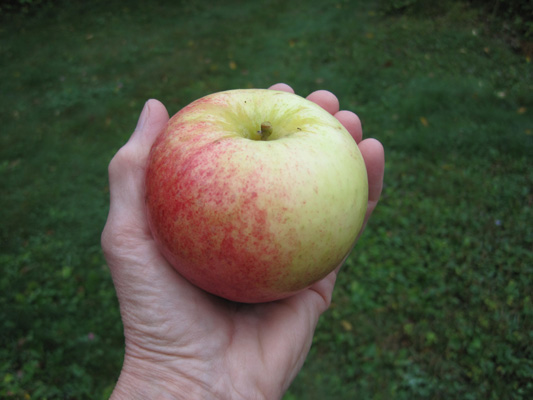
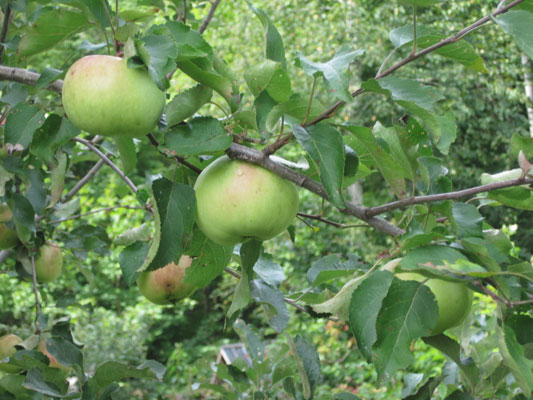 Our
third newby was grafted in 2014 - 3 fruit, still hanging (Oct. 1)on a
wild seedling tree outside the fence, I carefully
protected it from deer (I hope) with a ladder underneath to discourage
close contact (and give the squirrels a way to climb up Steve says)
(hah) (I expect LilliB to make sure that doesn't happen) and branches
pinned carefully across to hide the fruit, because these will likely not
be ready for several more weeks. We have had this one before from the
tree we got our scion from. An old tree, growing outside the front door
of an old farmhouse friends had bought. When the house burned down the
only thing left was this tree (they rebuilt, a really nice house). They
figure the tree was planted early 1900's. They gave us a bucket of
apples awhile back and we liked them so much we asked to cut a scion for
our own tree. We grafted one piece on its own rootstock and it is
growing well but will probably be some more years before it has a crop.
We also grafted a piece onto the branch of a mature wild tree, and
this is the one that has fruit. It is a nice, mild, fairly sweet
green/yellow apple that stores well. They guessed it might be a Golden
Delicious but don't really know for sure.
Our
third newby was grafted in 2014 - 3 fruit, still hanging (Oct. 1)on a
wild seedling tree outside the fence, I carefully
protected it from deer (I hope) with a ladder underneath to discourage
close contact (and give the squirrels a way to climb up Steve says)
(hah) (I expect LilliB to make sure that doesn't happen) and branches
pinned carefully across to hide the fruit, because these will likely not
be ready for several more weeks. We have had this one before from the
tree we got our scion from. An old tree, growing outside the front door
of an old farmhouse friends had bought. When the house burned down the
only thing left was this tree (they rebuilt, a really nice house). They
figure the tree was planted early 1900's. They gave us a bucket of
apples awhile back and we liked them so much we asked to cut a scion for
our own tree. We grafted one piece on its own rootstock and it is
growing well but will probably be some more years before it has a crop.
We also grafted a piece onto the branch of a mature wild tree, and
this is the one that has fruit. It is a nice, mild, fairly sweet
green/yellow apple that stores well. They guessed it might be a Golden
Delicious but don't really know for sure.
 This
has become for me a pleasant and enjoyable job to look forward to in
March. Scions are 6-10" sticks of wood from a particular variety of
fruit tree, to be grafted onto either a seedling or a larger tree to
grow the fruit of that particular variety. This year I have scions of
pear, apple and tart cherry obtained from various sources. Some are from
the wonderful U.S. National Plant Germplasm Repository of the Dept of
Agriculture, some purchased from nurseries, and many exchanged with or
gifted from other amateur fruit growers from across the country. It's
fun to send as well as receive! N
This
has become for me a pleasant and enjoyable job to look forward to in
March. Scions are 6-10" sticks of wood from a particular variety of
fruit tree, to be grafted onto either a seedling or a larger tree to
grow the fruit of that particular variety. This year I have scions of
pear, apple and tart cherry obtained from various sources. Some are from
the wonderful U.S. National Plant Germplasm Repository of the Dept of
Agriculture, some purchased from nurseries, and many exchanged with or
gifted from other amateur fruit growers from across the country. It's
fun to send as well as receive! N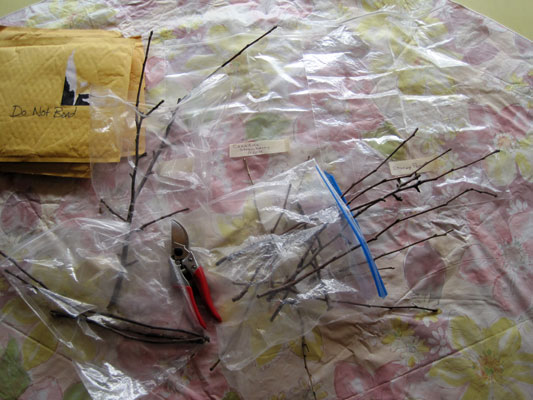 ot
all my scions have arrived yet but we'll probably have 30 or so to graft
later in the spring.
ot
all my scions have arrived yet but we'll probably have 30 or so to graft
later in the spring. 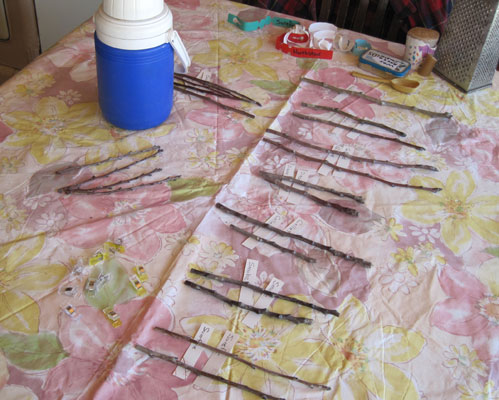
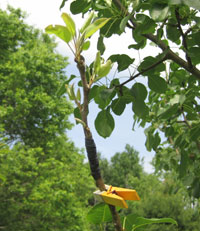 One,
of many, joys of early summer for me is watching our current season
grafts for signs of life - that wonderful little bit of green in the
scion buds that says "there's hope!". Slowly, growing and unfolding,
there's a small leaflet - "there's a good chance now!". A few more
leaves, more buds popping - "Yes! It's likely a take!". This is where we
are now - 46 grafts at all stages - apples, pears, plums, cherries -
including some that haven't shown signs of life yet (but there's still
hope). There are a lot of variables involved in grafting. As with all
young things, the first months, and years, are very undecided. Some stay
for the long haul, some don't make it past the first year, but the
beginnings are all so very sweet and exciting.
One,
of many, joys of early summer for me is watching our current season
grafts for signs of life - that wonderful little bit of green in the
scion buds that says "there's hope!". Slowly, growing and unfolding,
there's a small leaflet - "there's a good chance now!". A few more
leaves, more buds popping - "Yes! It's likely a take!". This is where we
are now - 46 grafts at all stages - apples, pears, plums, cherries -
including some that haven't shown signs of life yet (but there's still
hope). There are a lot of variables involved in grafting. As with all
young things, the first months, and years, are very undecided. Some stay
for the long haul, some don't make it past the first year, but the
beginnings are all so very sweet and exciting.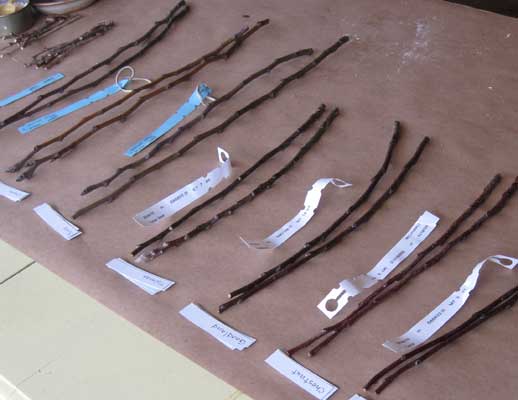 This
year I ordered some scions of varieties I couldn't find elsewhere from
the US National Plant Germplasm System. It's an incredible resource,
underfunded and understaffed with very dedicated people who cut and send
out hundreds of cuttings from their vast collections of trees for those
who want to trial (or breed) different varieties. For me, it's finding
apple and pear varieties that will grow well in this area but aren't
common here (often from Canada). And they are very generous with the
amount of wood they send. Most sources send one or two 6" pieces (which
actually is plenty) but not these folks. They want to make sure you have
what you need. And they are excellent cuttings.
This
year I ordered some scions of varieties I couldn't find elsewhere from
the US National Plant Germplasm System. It's an incredible resource,
underfunded and understaffed with very dedicated people who cut and send
out hundreds of cuttings from their vast collections of trees for those
who want to trial (or breed) different varieties. For me, it's finding
apple and pear varieties that will grow well in this area but aren't
common here (often from Canada). And they are very generous with the
amount of wood they send. Most sources send one or two 6" pieces (which
actually is plenty) but not these folks. They want to make sure you have
what you need. And they are excellent cuttings.
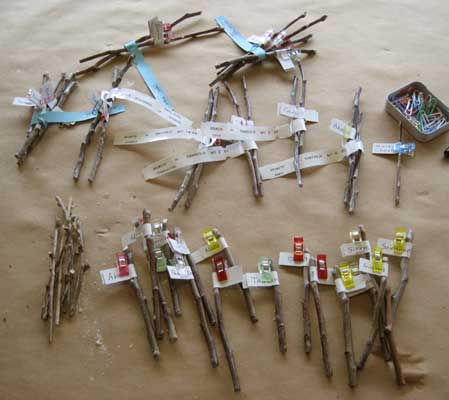 Scions
have to be cut when the tree is dormant and kept in that state until
ready to graft. But one doesn't graft until trees start to grow in the
spring. So you keep them well wrapped (so they don't dry out) and cool
until then. Sometimes all I do is triple wrap them in plastic bags and
store in the root cellar. But this year I decided to wax them now before
storing. This keeps the scion from drying both now and after they're
grafted. Plus it's fun. So today was the day to sort, admire, cut to
length, wax, label and carefully wrap and store all the sticks I have so
far. Since I had so much extra wood I also prepared pieces of each
variety and potted them to try rooting them to grow on their own roots
(instead of grafting). It's rare to be successful at this but that's all
the more reason to try! So the main waxed scions are securely stored in
the root cellar and a collection of adventurous cuttings are warmly
hanging out and hopefully thinking of rooting in pots by the woodstove.
A good day for all.
Scions
have to be cut when the tree is dormant and kept in that state until
ready to graft. But one doesn't graft until trees start to grow in the
spring. So you keep them well wrapped (so they don't dry out) and cool
until then. Sometimes all I do is triple wrap them in plastic bags and
store in the root cellar. But this year I decided to wax them now before
storing. This keeps the scion from drying both now and after they're
grafted. Plus it's fun. So today was the day to sort, admire, cut to
length, wax, label and carefully wrap and store all the sticks I have so
far. Since I had so much extra wood I also prepared pieces of each
variety and potted them to try rooting them to grow on their own roots
(instead of grafting). It's rare to be successful at this but that's all
the more reason to try! So the main waxed scions are securely stored in
the root cellar and a collection of adventurous cuttings are warmly
hanging out and hopefully thinking of rooting in pots by the woodstove.
A good day for all.
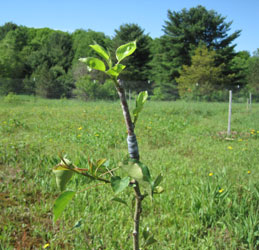 The most exciting point in grafting, to me, is that moment when one finally sees
growth in a scion's bud(s), and you know there's a very good chance that your graft
was successful. Many amateur grafters admit they check their grafts often
(weekly? daily? hourly?!) for that little bit of green emerging from a bud that holds such
wonderful promise. It could be a week, or two, or four, sometimes longer before
that magical event occurs but it is a great cause for celebration, even if (and
probably best if) only the birds and bees see the jump and shout of
joy that happens upon that discovery. It has been three weeks since we
grafted and 2/3 of our grafts show green growth now, from a little bit to
significant leafing. Some others are close (buds swelling), others are holding out, not committing to
growth yet. But there is still time. Our unusual (very unusual!) hot (to us) (days
near 80) first half of June, with PLENTY of rain, making everything grow with
unbounded enthusiasm has likely helped our scions grow faster than usual. Later
I'll start dreaming of the fruit that these little trees will someday produce,
but for now it is enough that they have decided to grow.
The most exciting point in grafting, to me, is that moment when one finally sees
growth in a scion's bud(s), and you know there's a very good chance that your graft
was successful. Many amateur grafters admit they check their grafts often
(weekly? daily? hourly?!) for that little bit of green emerging from a bud that holds such
wonderful promise. It could be a week, or two, or four, sometimes longer before
that magical event occurs but it is a great cause for celebration, even if (and
probably best if) only the birds and bees see the jump and shout of
joy that happens upon that discovery. It has been three weeks since we
grafted and 2/3 of our grafts show green growth now, from a little bit to
significant leafing. Some others are close (buds swelling), others are holding out, not committing to
growth yet. But there is still time. Our unusual (very unusual!) hot (to us) (days
near 80) first half of June, with PLENTY of rain, making everything grow with
unbounded enthusiasm has likely helped our scions grow faster than usual. Later
I'll start dreaming of the fruit that these little trees will someday produce,
but for now it is enough that they have decided to grow. 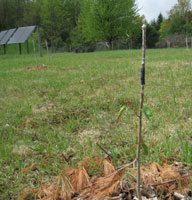 The
weather came through with temps in the 60's and a mostly sunny day for our
Grafting Day. We had 26 grafts to do, the most we've ever done in one year --
apples, plums, pears, cherries -- and it went well. Steve does the knife work
(all whip and tongue grafts except for a few very thin scions where there simply
wasn't enough wood so we did a simple splice graft). Then I do my best to hold
them carefully in place while wrapping first with a slightly stretchy Parafilm
tape, then with regular rubber electrical splicing tape. The W&T technique
really helps hold the two pieces together with the thin layers of cambium lined
up (scion with the rootstock) while wrapping. The tape keeps the two firmly
together until the graft calluses, fusing the scion to the rootstock on its way
to being a new tree. I realize you need a good imagination to see how I could be
excited about the stick in the photo! But that is a Patten pear scion (just a
piece of last years growth cut from a Patten tree) grafted to a Ussuriensis pear
(very hardy) rootstock. Some time in the future we will be eating tasty pears
from a full size tree that started as this little stick. I have an old photo of
a Patten Pear growing at the Chatham Experiment station in 1945 (back when they
had an experimental orchard). Patten is a cross from the Univ. Minnesota
introduced in 1922.
The
weather came through with temps in the 60's and a mostly sunny day for our
Grafting Day. We had 26 grafts to do, the most we've ever done in one year --
apples, plums, pears, cherries -- and it went well. Steve does the knife work
(all whip and tongue grafts except for a few very thin scions where there simply
wasn't enough wood so we did a simple splice graft). Then I do my best to hold
them carefully in place while wrapping first with a slightly stretchy Parafilm
tape, then with regular rubber electrical splicing tape. The W&T technique
really helps hold the two pieces together with the thin layers of cambium lined
up (scion with the rootstock) while wrapping. The tape keeps the two firmly
together until the graft calluses, fusing the scion to the rootstock on its way
to being a new tree. I realize you need a good imagination to see how I could be
excited about the stick in the photo! But that is a Patten pear scion (just a
piece of last years growth cut from a Patten tree) grafted to a Ussuriensis pear
(very hardy) rootstock. Some time in the future we will be eating tasty pears
from a full size tree that started as this little stick. I have an old photo of
a Patten Pear growing at the Chatham Experiment station in 1945 (back when they
had an experimental orchard). Patten is a cross from the Univ. Minnesota
introduced in 1922.
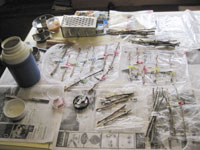 This year
(2017) I decided to try dipping the scions in melted wax before grafting as
recommended by a number of folks on the Growing Fruit forum. I found a wide
mouth plastic insulated 'thermos' at the thrift store, shaved maybe an inch
of beeswax and old candle wax into it, filled it with boiling hot water and
organized my scions on the table. It was fun and reminded me of early years
when we used to make dozens of dipped candles for our use (I still have
dozens of dipped candles! Now we have
dozens of LED lights all over the house!).
This year
(2017) I decided to try dipping the scions in melted wax before grafting as
recommended by a number of folks on the Growing Fruit forum. I found a wide
mouth plastic insulated 'thermos' at the thrift store, shaved maybe an inch
of beeswax and old candle wax into it, filled it with boiling hot water and
organized my scions on the table. It was fun and reminded me of early years
when we used to make dozens of dipped candles for our use (I still have
dozens of dipped candles! Now we have
dozens of LED lights all over the house!).